DINOTOPIA - THE CODES, RULES AND REGS
according to the TV movie - DINOTOPIA
BY DISNEY
"FIND THE LIGHT"
compiled by Dee Finney
5-18-2002 |
Where is DINOTOPIA?
Nobody knew until the discovery of the SUNSTONE mine. It has to be
in the Yucatan area according to the clues given in the film.
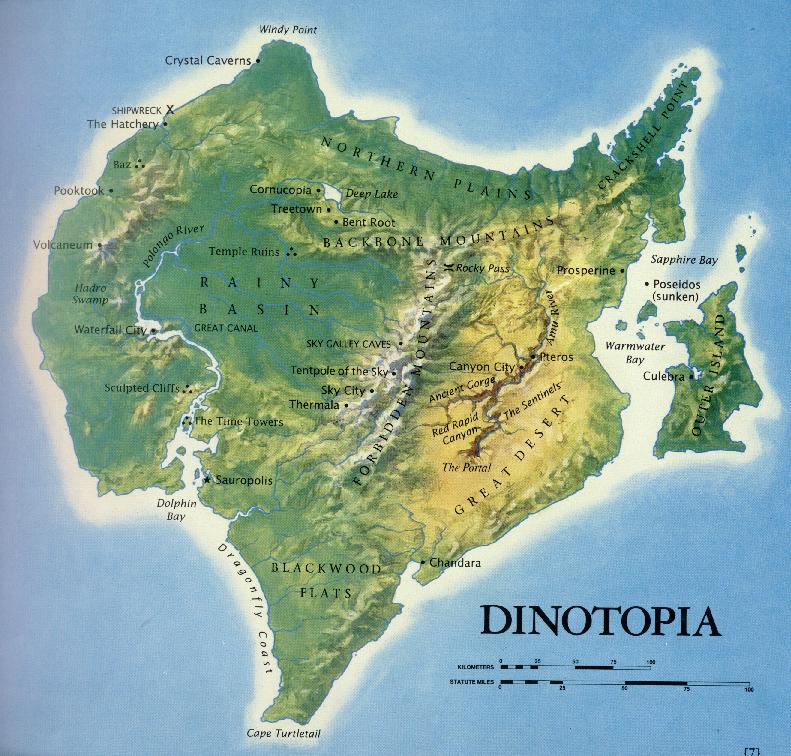
Click on map to get larger version
|
THE CODES
1 - One raindrop raises the sea.
2 - Survival of all or none
3 - Weapons are enemies, even to their owners
4 - Give more - take less
5 - Others first - self last
6 - Observe, listen and learn
7 - Do one thing at a time
8 - Sing every day
9 - Exercise imagination
10 - Eat to live, don't live to eat
11 - FIND THE LIGHT
|
OTHER IMPORTANT INFORMATION ABOUT DINOTOPIA |
Sunstones are the source of power and safety.
I must be calm in a crisis if I expect to inspire others
Dinotopians are vegetarians. They eat only fruits and
vegetables.
Violence is looked down upon in Dinotopia. Humans are guests
there. Dinosaurs feel pride in their strength.
 One
can learn a lot from a Brachiosaurus - like humility. The Brachiosaurus
are used to pull the overland 'buses' and to pull ploughs. They do this by
choice, not because the have to.
One
can learn a lot from a Brachiosaurus - like humility. The Brachiosaurus
are used to pull the overland 'buses' and to pull ploughs. They do this by
choice, not because the have to.
Everything on earth has the same heartbeat if you listen!
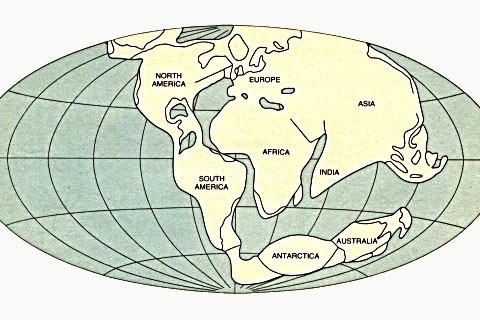 In
Dinotopia, the world globe looks like the ancient Pangea where Europe is
connected to America
In
Dinotopia, the world globe looks like the ancient Pangea where Europe is
connected to America
Thousands of shipwrecked sailors found their way to the shores of
Dinotopia. It is a land of harmony and fulfillment.
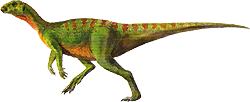 Dryosaurier
were used for individual transportation.
Dryosaurier
were used for individual transportation.
All new Dinotopians are paired with a Saurian - a dinosaur of some
type. They go through a ceremony - like a marriage. a spiritual partnering.
All dinosaurs hold equal status with humans, including in the government.
Humans and Saurians communicate, some with English language, some with sounds
and feelings.
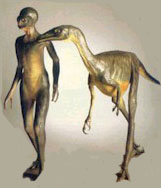 The
tall bird, Stenosaurus, Saurians can speak as many as 17 languages.
All humans are taught to read, write, and speak the Saurian language as well.
Zippo is a 6-foot tall green "Stenosaurus," based on a Stenonychosaurus or
Troodon. (The picture on right is for size comparison)
The
tall bird, Stenosaurus, Saurians can speak as many as 17 languages.
All humans are taught to read, write, and speak the Saurian language as well.
Zippo is a 6-foot tall green "Stenosaurus," based on a Stenonychosaurus or
Troodon. (The picture on right is for size comparison)
The Dinotopian way is the 'reasoned' way
A good mind is a calm mind
Dinotopia is a Utopia where everyone lives in harmony
When a regular person says, "Breathe free" you respond "Seek
Peace"
If you are in the flying forces and someone says "Breathe free" you
respond "Fly high!"
'The World Beneath' is the mythological(?) place where the dinosaurs
found sanctuary at the dawn of time. This is also where the sunstones
originate. There is a code that says that the sacred space
of the carnivores in the 'World Beneath' cannot be violated. The "World Beneath"
was occupied at first by the dinosaurs, and then later by human cultures.
The "World Beneath runs under the entire length and breadth of Dinotopia,
at least 200 miles.
There is a temple named Kura, which has 3 entrances, one of which
is under the ocean, one at the bottom of a well in
Waterfall City, and one
in the forest. The temple itself is on top of a very high hill.
How can you want anything other than your destiny? How do you
find your destiny? You don't - it finds you!
There are 361 steps up to the sunstone in the 'lighthouse' in Waterfall
city.
The main sunstone empowers all the other sunstones when dusk comes.
The sunstone cave must be in the Yucatan because the sunstone is the crystallized
meteor that hit the earth and wiped out all the dinosaurs that stayed above
the earth at the time.
The corbelled arch of the temple is strictly Mayan in
construction.
The Dinosaurs has a course book titled, "The Care and Teaching of
Humans"
A Dinosaur/Human (half saurian, half human) named OgFaar ruled over
the underground land of "The World Beneath". He was the founder
of Poseidous, and carried a trident staff.
The Stone carving looks much like those in Zechariah Sitchin's books.
It is said that the entrances to the "World Beneath" are guarded
by carnivores. (Crocodiles)
All the written communications are done in a language that looks
like 3-toed bird dinosaurs
The graduation question in the school system is, "How are we to
live?"
The Dinotopian Earth farm is 7,000 acres, it is a working community
with fields, and a hatchery. It provides half of the food for Waterfall City
which is the nearest city. The hatchery is where Dinosaur orphan eggs are
hatched.
The matriarch of the Earth farm says that people need to learn to
be closer to the earth.
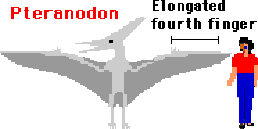 In Canyon City, where the Skybax Corps are trained. (airforce)
there are 4,200 Dinotopian people living and working there and only
12 new Skybax are selected each year. The new Skybax
are trained, but selected by the 'bird' who will carry them. If a 'bird'
(The 'good' Pteranodons), doesn't select them to ride
them, because they sense fear in your heart, they do not graduate from the
course and are dismissed from the Corps.
In Canyon City, where the Skybax Corps are trained. (airforce)
there are 4,200 Dinotopian people living and working there and only
12 new Skybax are selected each year. The new Skybax
are trained, but selected by the 'bird' who will carry them. If a 'bird'
(The 'good' Pteranodons), doesn't select them to ride
them, because they sense fear in your heart, they do not graduate from the
course and are dismissed from the Corps.
In the canyon where the training is done, there is a series of tall,
thin statues of people called 'Sentinel's. Each one holds a sunstone
in its hands, which lights up during the night. Above them is the sky world
of the Skybax, and below them is ruled by the
Pteranodons (the nasty black birds). The canyon is 6,000
feet deep. Since the Pteranodons split in past history,
they have not been able to communicate with them, and the 'bad'
Pteranodons have been becoming more and more hostile
and violent and aggressive.
CLUE: The nasty Pteranodons don't like the
'light'.
You must face your fear if you are to overcome it. Fear is the future.
There is no fear in the present. The present is only action and
reaction.
Dinotopians must go where the 'current' takes them! (Go with
the flow!)
FINAL NOTE: THE GATEWAY TO THE 'WORLD BENEATH' IS OPEN
AGAIN!
'DINOTOPIA' WILL BECOME A WEEKLY SERIES ON TELEVISION IN THE FALL OF
2002
DINOTOPIA: THE OFFICIAL
WEBSITE
THE OFFICIAL DISCUSSION
BOARD
DINOTOPIA DISCUSSION
GROUP
BUY
THE BOOK
Pteranodons in Detail
Pteranodons were flying reptiles (pterosaurs) that were about 6 feet (1.8
m) long, had a 25-33 foot (7.8-10 m) wingspread, and weighed about 35 pounds;
its standing height was about 6 feet (1.8 m). This wing-span is longer than
any known bird. Pteranodons had hollow bones, were lightly built, had almost
no tail, and small bodies; they may have had fur. They had large brains and
good eyesight. Some pteranodons had long, light-weight, bony crests on their
heads that may have acted as a rudder or stabilizer when flying, or may have
been a sexual characteristic. They had no teeth. Pteranodon wings were covered
by a leathery membrane. This thin but tough membrane stretched between its
body, the top of its legs and its elongated fourth fingers, forming the structure
of the wing. Claws protruded from the other fingers.
CLASSIFICATION
Pteranodons were reptiles, but not dinosaurs. By definition, all dinosaurs
were diapsid reptiles with an upright stance. Pterosaurs probably had a
semi-upright stance. There is a small minority of paleontologists who think
that the pterosaurs' stance could have been upright and that pterosaurs should
therefore be included in the clade of dinosaurs (being derived theropods).
Either way, dinosaurs and pterosaurs are certainly closely related.
More Details:
http://www.enchantedlearning.com/subjects/dinosaurs/dinos/Pteranodon.shtml
Brachiosaurus in Detail:
Height: 50 feet (15.2 meters) Length: 100 feet (30.5 meters) Weight: 120,000
lbs (54,432 kg) Period: Late Jurassic
Brachiosaurus is one of the largest known land animals, based on a complete
skeleton found in Tanzania. Each neck vertebra was more than 3 feet (1 meter)
long. Its large nostrils were located on top of its head, which caused
speculation that Brachiosaurus might have spent time submerged in water.
However, recent studies have shown that a creature as large as Brachiosaurus
could not have inhaled and inflated its lungs against the water pressure
at depths of total submergence. Its front legs were longer than its rear
legs and it stood 24 feet (7.3 meters) at the shoulder. It had small narrow
feet for its size and the first digit of the front foot had a claw as did
the first three digits of the hind foot. The function of the claws is unknown
though they may have been used for raking plants or in self defense.
Further Evidence
of the Affinity between the Dinosaurian Reptiles and Birds
Dryosaurier in Detail:
Dryosauridae indet.
A seeming leg bone made of whale gap comes from a plant-corrosive genuine
dinosaur, a Dryosaurier. These
were fast runners and possibly lived in herds. Kadaver of such Landsaurier
were rinsed with the rivers at that time as well as driving woods into the
sea basin. Since the water corpses drove finally some time and the skeleton
disintegrated into individual bones, no whole skeletons in the Ornaten clay/tone,
but only such coincidence finds are to be expected. Dryosaurus altus
With narrow eyes, stiff tail and a swift runner, oak reptile or Dryosaurus
was a late Jurassic, biped plant eater and lived 170 million years ago.
Dryosaurus being two-legged, it could be possible that it was a fast runner
and it is also believed that it ran in herds if followed by hungry meat eaters.
Dryosaurus had long arms and long hands with five fingers helping it in grasping
leaves and plants. It had a nice beak and possibly large cheeks helping it
to hold food in place while chewing. It also had many grinding teeth far
back in its mouth.
Dryosaurus was even more advanced than other of its family; it was a larger
one of its family. It could grow up to a length of 4 metres (13.3 feet) and
weigh almost 2 tons. Some fossils of Dryosaurus found in Romania suggest
that Dryosaurus roamed about in herds in plains of Romania and other such
European places.
Order: Ornithischia
Sub order: Ornithopoda
Family: Dryosauridae.
Stenonychosaurus in Detail:
Stenonychosaurus, was according to paleontologists remarkably
hominoid in appearance. It was less than 3 m long, and weighed only 45 kg.
It was a biped, and could rotate its lower arm to grasp objects with a
three-fingered hand. The eyes were enormous, surpassing in size those of
most modern land animals. The brain was much larger than in living
reptiles and approached that of some living birds and mammals in relative
size. Stenonychosaurus dinosaurs, which probably
fed on primitive mammals, embody a widespread tendency for the brain to increase
in size through the history of life. It had possibly greyish-green skin and
three-digit clawed fingers with a partially-opposable 'thumb'. Stenonychosaurus
had large eyes, slender flexible fingers, and a light body. The brain was
probably concerned mainly with its highly developed senses, fine control
of its limbs, and fast reflexes, which were used in hunting small and elusive
prey.
WAS THERE A
DINOMAN?
MORE ON THE
STENONYCHOSAURUS/TROODON
The Sunstone:
The sunstone unfortunately does not look like the one in the movie.
Here is what they
really look like.
Background on Sunstone
Sunstone is a species of feldspar called "oligoclase" or known sometimes
in the jewelry industry as "adventurine feldspar". It gets is shiller in
the same way that labradorite does, but the background color is brown to
orange to red. In addition, sunstone contains small hematite crystals that
give it additional sparkle. The sparkle is known as aventuresence
Oregon Sunstone
Sunstone is the State Gem of Oregon, which is a prime source for this beautiful
Gem. Cleaner Red sunstone is MUCH, MUCH rarer and commands true Gemstone
prices! It is a rare and sought after collector's item. Oregon Sunstone differs
from sunstones found in other worldwide locales in color, a strong pleochroism,
and a glittering Schiller effect created by pure native copper. In fact,
the presence of these bright inclusions was the reason for naming it Sunstone
or Heliolite, from the Greek helios for sun and lithos for stone.
Mining and use of Sunstone
Oregon sunstones are mined from the surface from partially decomposed rock
with a pick and shovel. Shallow pits are dug to retrieve the rough. Unweathered
deposits release rough only by blasting and tunneling which often shatters
the sunstone rough. The mining season averages approximately six months.
In addition to the United States, India, Canada, South Norway and Russia
are sources of sunstone. The Indian material is a medium dark orange, which
is very attractive. Much sunstone is metallic in appearance due to reflective
inclusions of red, orange or green crystals. A relatively soft stone, Sunstone
ranges from 6-6½ on the MOHS scale. It is
popular as an ornamental stone and as well as a gemstone for use in jewelry.
Sunstone is not enhanced.
MORE RELATED LINKS
REPTILIANS
OTHER
DINOTOPIAN LINKS
AUTHOR JAMES GURNEY
GREATDREAMS.COM MAIN INDEX


 One
can learn a lot from a Brachiosaurus - like humility. The Brachiosaurus
are used to pull the overland 'buses' and to pull ploughs. They do this by
choice, not because the have to.
One
can learn a lot from a Brachiosaurus - like humility. The Brachiosaurus
are used to pull the overland 'buses' and to pull ploughs. They do this by
choice, not because the have to.
 In
Dinotopia, the world globe looks like the ancient Pangea where Europe is
connected to America
In
Dinotopia, the world globe looks like the ancient Pangea where Europe is
connected to America
 Dryosaurier
were used for individual transportation.
Dryosaurier
were used for individual transportation.
 The
tall bird, Stenosaurus, Saurians can speak as many as 17 languages.
All humans are taught to read, write, and speak the Saurian language as well.
Zippo is a 6-foot tall green "Stenosaurus," based on a Stenonychosaurus or
Troodon. (The picture on right is for size comparison)
The
tall bird, Stenosaurus, Saurians can speak as many as 17 languages.
All humans are taught to read, write, and speak the Saurian language as well.
Zippo is a 6-foot tall green "Stenosaurus," based on a Stenonychosaurus or
Troodon. (The picture on right is for size comparison)